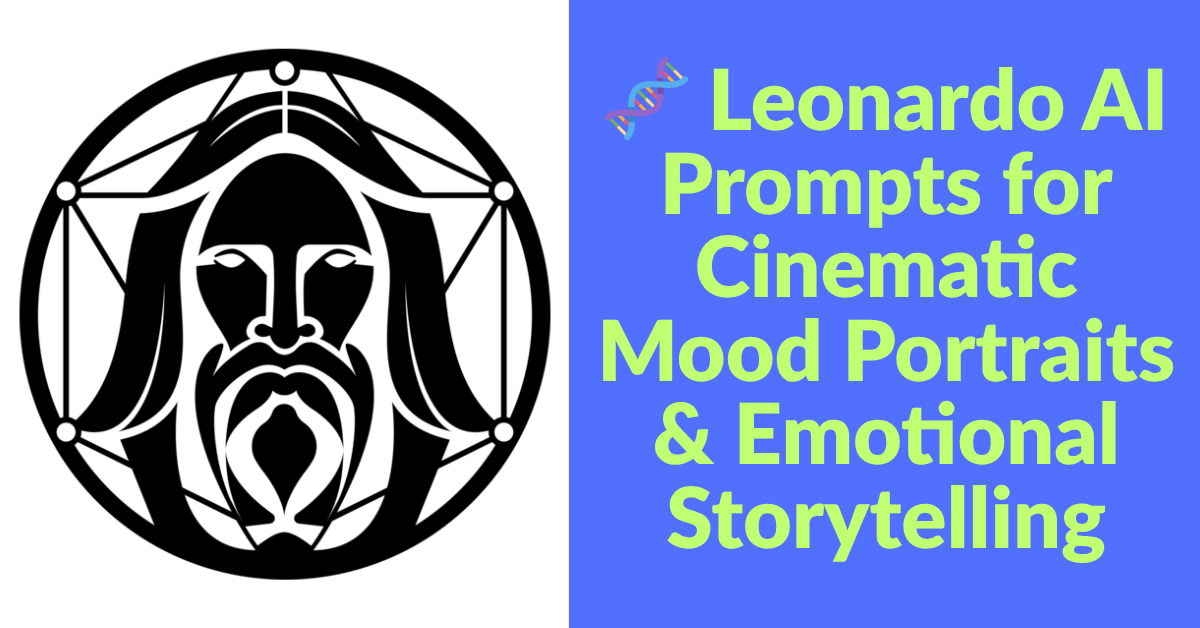
🧬 Leonardo AI Prompts for Cinematic Mood Portraits & Emotional Storytelling
-
by AiPrompt
- 108
There’s something undeniably powerful about a well-lit portrait that feels like a frame from a film. That one image that doesn’t just show a face — it tells a story. Whether it’s grief, love, anticipation, or triumph, cinematic portraiture can make AI-generated images feel *real*, emotional, and human.
Leonardo AI is quickly becoming one of the top tools to craft mood-rich visuals, especially when your prompts are focused on *storytelling through facial emotion*. Unlike generic descriptions, cinematic prompts lean on specific lighting setups, character emotions, background tension, and atmosphere — just like in a movie scene.
In today’s handpicked collection, I’m sharing my **top Leonardo AI prompts for cinematic mood portraits**. These are perfect if you’re aiming for expressive faces, editorial-style compositions, dramatic tension, or storytelling-packed visuals for graphic novels, films, music covers, or concept art. Ready to bring the drama?
🧬 Leonardo AI Prompts for Cinematic Mood Portraits & Emotional Storytelling
Prompt #1: Close-up portrait of a woman under rainy window light, melancholy gaze, shallow depth of field, cinematic tones
Prompt #2: A man in a dim hallway holding a cigarette, shadows across his face, silent intensity, dramatic tension
Prompt #3: Teenage girl with headphones looking out a bus window at night, neon reflections, lost in thought
Prompt #4: Elderly man with deep wrinkles lit by warm lamp glow, eyes full of stories, nostalgic mood
Prompt #5: Close-up of a woman crying in the dark, one spotlight overhead, grainy cinematic look, emotional release
Prompt #6: Man staring at city skyline from rooftop at dusk, dramatic clouds, backlit silhouette, cinematic angle
Prompt #7: Woman laughing while walking through a crowd, candid motion blur, dreamy glow, film-style capture
Prompt #8: Portrait of a young man with bloodshot eyes in a motel room, broken neon light, intense atmosphere
Prompt #9: Artist in a paint-covered apron looking down at unfinished canvas, emotional expression, dusty lighting
Prompt #10: Woman looking back through a train window, foggy background, bittersweet expression, story-rich framing
❓ FAQs
Q1: What defines a cinematic portrait?
A: It’s more than just lighting — cinematic portraits tell a story using emotion, composition, background tension, and drama.
Q2: How do I get that “movie still” look?
A: Use terms like “cinematic lighting,” “film grain,” “dramatic shadows,” or “frame from a movie scene.”
Q3: What makes a portrait emotionally effective?
A: Use prompts with character backstory, mood details, and emotional nuance — like regret, triumph, sadness, or inner peace.
Q4: Are these prompts good for character-driven visuals?
A: Yes — especially for book covers, films, music visuals, or storytelling-based art projects.
Q5: Can Leonardo AI replicate subtle facial emotions?
A: With the right lighting, camera angle, and expression description — absolutely. Just be detailed and cinematic in phrasing.
🎬 Final Thought:
Leonardo AI is like your personal cinematographer — but only if you direct it well. Be precise, emotionally rich, and scene-driven in your prompts. That’s the key to making your portraits feel like they were pulled straight from the silver screen.
Related posts:
There’s something undeniably powerful about a well-lit portrait that feels like a frame from a film. That one image that doesn’t just show a face — it tells a story. Whether it’s grief, love, anticipation, or triumph, cinematic portraiture can make AI-generated images feel *real*, emotional, and human. Leonardo AI is quickly becoming one of…
There’s something undeniably powerful about a well-lit portrait that feels like a frame from a film. That one image that doesn’t just show a face — it tells a story. Whether it’s grief, love, anticipation, or triumph, cinematic portraiture can make AI-generated images feel *real*, emotional, and human. Leonardo AI is quickly becoming one of…
